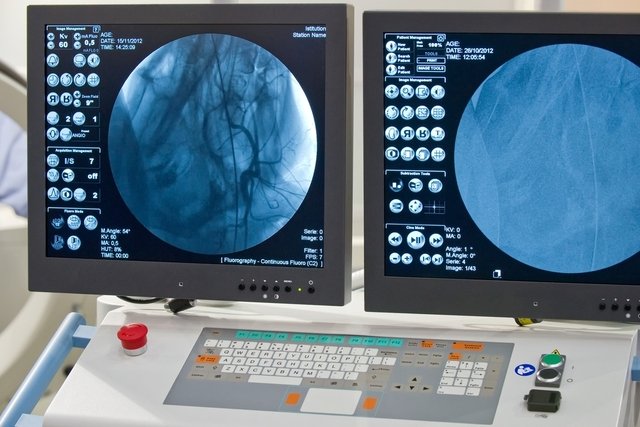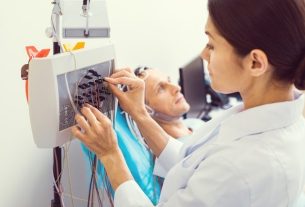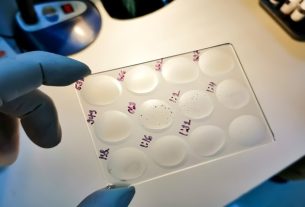Angiography, also known as arteriography, is an exam used to visualize blood vessels and analyze blood circulation within them. It is indicated for the diagnosis of diseases such as aneurysm, vessel malformations, cerebral hemorrhage, atherosclerosis and even to investigate and locate bleeding or blockages in vessels present in the abdomen, heart and kidneys, for example.
This exam can be done on different parts of the body, such as the brain, heart or lungs and, although it is usually done with X-rays, magnetic resonance imaging or computed tomography can sometimes also be used.
Before undergoing angiography, it is important to talk to your doctor due to risks such as bleeding and changes in kidney function. Generally, angiography is done in the hospital with local anesthesia and the person can return home a few hours after the exam is finished.

What is angiography for?
Angiography is indicated for the diagnosis of:
- aneurysms;
- Vessel malformations;
- Hemorragia cerebral;
- Obstruction of blood vessels;
- Pulmonary hemorrhage;
- Diabetic retinopathy;
- Tumors;
- Locate bleeding.
Furthermore, angiography can also be indicated in the treatment of some diseases such as gastrointestinal bleeding, coronary artery disease, vessel fistulas, uterine fibroids and varicocele, for example.
Types of angiography
The main types of angiography are:
- Cerebral angiography: it is indicated to evaluate the blood vessels of the brain and identify changes such as malformations, aneurysms and atherosclerosis plaques in the vessels;
- Coronary angiography: It is normally used to evaluate the blood vessels of the heart. Also known as cardiac catheterization;
- Ocular angiography or fluorescein angiography: is used to identify changes in vessels in the retina using a special camera to obtain images;
- Pulmonary angiography: allows the assessment of blood circulation through the vessels of the lungs, and may be indicated in cases of suspected pulmonary embolism and vessel malformations, for example.
In addition, there are currently also less invasive angiography techniques that use computed tomography or magnetic resonance imaging to assess blood circulation through the vessels.
How to prepare for the exam
To perform the exam, it is important to fast for around 8 hours to avoid vomiting and regurgitation of food, especially if the person requires sedation to perform the exam.
Furthermore, in some cases, it is necessary to stop taking some medications 2 to 5 days before the procedure, such as anticoagulants and aspirin, according to the doctor’s instructions.
How the exam is carried out
Angiography is performed by applying anesthesia at the site of the procedure and introducing a catheter, which is a thin tube, into an artery in the groin or wrist until it reaches the place where the blood vessels are to be observed.
After placing the catheter, the doctor injects the contrast and takes several X-ray images of the location where the tip of the catheter is, which allows the analysis of the blood vessels through which the contrast passes.
During the exam, the person normally remains awake, but as it is necessary to remain still, the doctor may apply medication to calm down, making it possible to feel a little sleepy.
This exam lasts about an hour and the person can return home within a few hours after finishing. In some cases, it may also be necessary to stitch and place a bandage where the catheter was inserted.
Care after the exam
In the 24 hours following the exam, you should not do physical activity, remaining at rest, to avoid bleeding. Commonly used medications should only be taken when prescribed by your doctor.
Risks of angiography
The most common risk of this exam is an allergic reaction to the contrast that is inserted, however the anesthetist is prepared to reverse this situation if necessary. Contrast can also cause kidney problems. Bleeding may also occur at the catheter insertion site. Know the risks of contrast exams.
Who should not have angiography
Angiography is normally not indicated for people with morbid obesity, pregnancy and a history of severe allergy to iodine contrasts.
Furthermore, this test may not be indicated for some people with blood clotting problems, due to the risk of bleeding, diabetics using metformin and in cases of diseases affecting the functioning of the kidneys.
Bibliography
- HANCOCK, Richard; HILDRED, Richard. Ocular angiography — a brief overview. International Journal of Ophthalmic Practice. Vol.3, n.2. 2044-5504, 2013
- AMERICAN ACADEMY OF OPHTHALMOLOGY. What Is Fluorescein Angiography?. Disponível em: <https://www.aao.org/eye-health/treatments/what-is-fluorescein-angiography>. Acesso em 22 mar 2023
- PALM, Viktoria et al. Acute Pulmonary Embolism: Imaging Techniques, Findings, Endovascular Treatment and Differential Diagnoses. Rofo. Vol.192, n.1. 38-49, 2020
- STATPEARLS. Angiography. 2022. Available at: <https://www.ncbi.nlm.nih.gov/books/NBK557477/>. Accessed on March 22, 2023
- NGAM, Pei I. et al. Computed tomography coronary angiography – past, present and future. Singapore Med J. Vol.61, n.3. 109-115, 2020

Sign up for our newsletter and stay up to date with exclusive news
that can transform your routine!
Warning: Undefined array key "title" in /home/storelat/public_html/wp-content/plugins/link-whisper-premium/templates/frontend/related-posts.php on line 12
Warning: Undefined array key "title_tag" in /home/storelat/public_html/wp-content/plugins/link-whisper-premium/templates/frontend/related-posts.php on line 13



